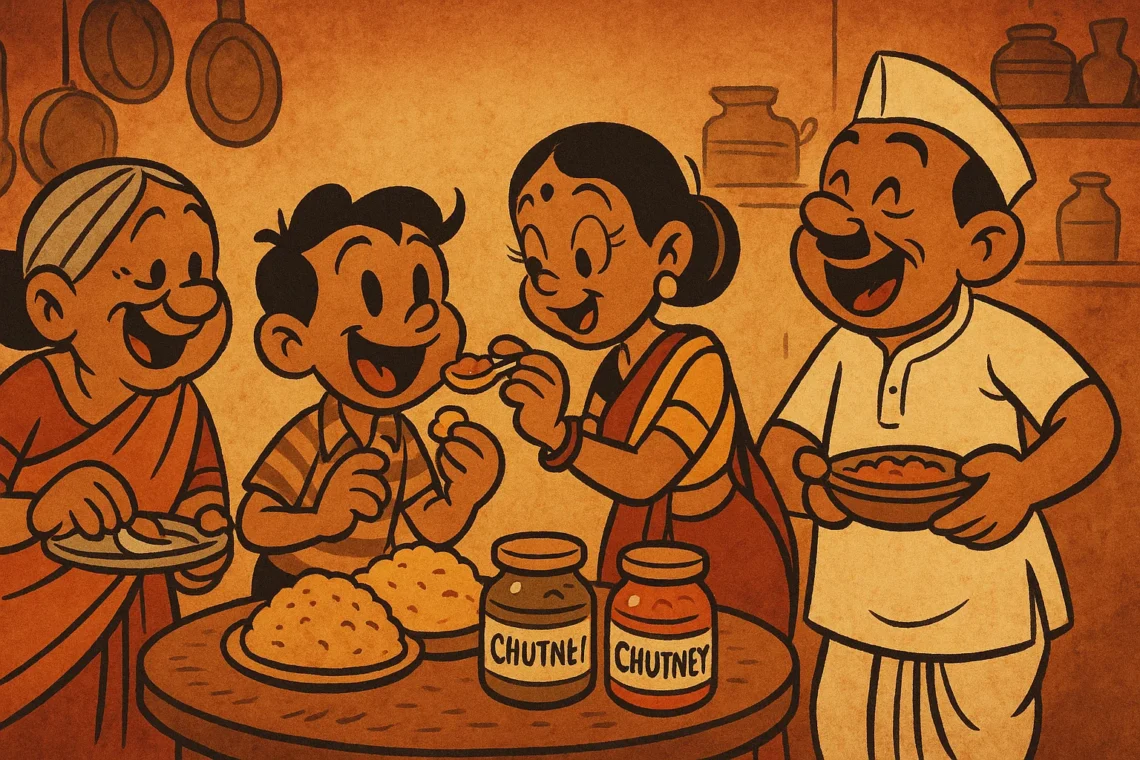Every home has its own system of rules—some written, most unwritten. And somewhere in that list, nestled between “don’t waste rice” and “close the fridge properly,” lives a quiet but fiercely observed tradition: the chutney hierarchy. Because while all chutneys are welcome on the plate, they are not all treated equally. Some are made fresh, with reverence. Others are bought in jars and judged. Some are essential, while others are just there for decoration. And at the top of this complex system of spreads and sides sits the undisputed royal—coconut chutney. Always served first. Always finished first. Always missed when absent.
At our breakfast table, chutneys didn’t just accompany the meal. They defined it. The idlis could be soft or stubborn, the dosa slightly under-crisped, but if the chutney was right, all was forgiven. And in that little katori of color and texture lived a miniature power struggle. Who made it, when it was made, and what it was made from—all dictated its rank for the day.
The Throne Belongs to Coconut
Freshly grated coconut, ground with green chilies, roasted chana dal, a touch of ginger, and a splash of tamarind—coconut chutney, especially when tempered with mustard seeds and curry leaves, is sacred. It cannot be replaced. No amount of coriander or tomato or garlic can compete with its ability to make breakfast feel complete. If you show up with pongal and no coconut chutney? That’s not a meal. That’s a misunderstanding.
It had to be made the same morning. My mother could tell if it was yesterday’s batch. “It’s turned sour,” she’d say with surgical precision, before offering it to the help with a kind smile and zero hesitation. The good stuff never survived past one sitting. A clean, scraped-out steel bowl was a sign that things had gone right.
The Supporting Cast
Then came the rest—coriander chutney, tomato-onion chutney, mint chutney. They had their moments. Coriander was bright and sharp and went well with upma. Tomato-onion gave off a restaurant vibe and was usually made when guests were around. Mint chutney was a wildcard, strong and moody, paired best with aloo tikkis or stuffed parathas. But these were not staples. These were the guest artists. If they weren’t on the table, no one asked questions. But when they showed up? Everyone paid attention.
The Jarred and the Judged
There were also the chutneys that came from jars. Sweet mango. Garlic chutney. Saunth. Pickle-chutney hybrids that lived at the back of the fridge. These were treated like old relatives—occasionally useful, rarely celebrated. We kept them “just in case,” but they never made it to the main table without someone saying, “We didn’t have time to make fresh today.” Even my father, a man of few culinary complaints, would politely ignore jar chutneys unless all other options had vanished.
Hierarchy in Action
Every Sunday morning dosa session was a live demonstration of this pecking order. The coconut chutney got the center spot on the thali. The coriander one sat to the side, quietly helpful. Tomato-onion, if it made an appearance, was treated like a luxury. And if by some miracle there was leftover pudina chutney from the night before, it was offered almost bashfully: “We have this too, but it’s from last night.”
Serving was strategic. You always scooped the coconut chutney first. You took more of it, instinctively. It was the one you reached for between bites, even if your dosa was already dipped in sambar. And when it started to run low, a quiet panic would set in. “Save some for the last bite,” someone would whisper. Because nothing is sadder than finishing breakfast with dry idli and no coconut to say goodbye.
Hierarchy, But With Heart
Of course, no one ever said, “This chutney is better than that one.” The rankings weren’t spoken—they were felt. Passed down through habit. Reinforced by the tilt of a ladle, the scrape of a spoon, the look of gentle disappointment when the hero of the table wasn’t fresh. And despite the jokes and judgments, there was love in every chutney. Even the store-bought ones. Even the chutney made with frozen coconut because someone forgot to buy fresh. It was still effort. Still flavor. Still home.
Because in the end, the chutney hierarchy isn’t about competition. It’s about memory. About how we show care with small bowls of spice. About the quiet politics of flavor, served every morning with warmth and a side of crispy dosa.
Born in Mumbai, now stir-frying feelings in Texas. Writes about food, memory, and the messy magic in between — mostly to stay hungry, sometimes just to stay sane.












